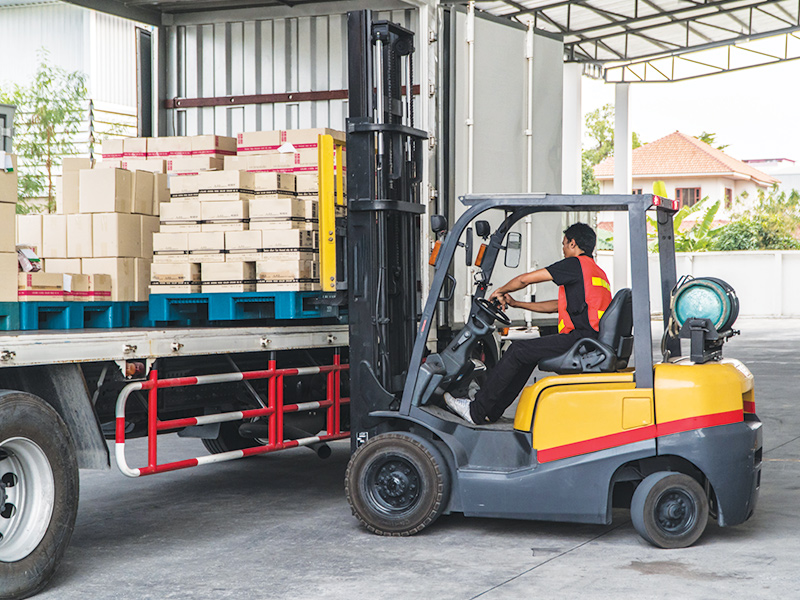Industry has leveraged the modern forklift for power, efficiency, and safety for more than a century. Here’s why propane has fueled so much of its progress.
The Evolution of Forklifts
Pre-1900 Hand trucks; battery-powered platform truck
1917 Tructractor - gas engine (diesel or compressed natural gas)
1920's-1940's Increasing industrial use and WWII spur rapid developments
1950's Propane introduced
2000's First electric forklifts
2006 Improved sulfur emissions requirements for diesel fuel
2018 Propane-powered forklifts still dominate market
For centuries, humans performed backbreaking work to lift and haul heavy loads, but it wasn’t until the early part of the 1900’s that technology evolved to introduce the forklift, an invention which could haul enormous loads with relative ease and over time, the forklift became a necessity in high volume warehouses and factories.
Today there are about a million forklifts in service throughout the world. And as of 2018, more than 600,000 of them were running on propane-fueled engines, according to a spokesperson from the Propane Education and Research Council. There are a variety of reasons that Forklift operators can trust propane to power their forklifts over other types of fuels such as diesel, compressed natural gas and electric. Let’s take a closer look and explore the history of this helpful machine for some additional insights.
From hand truck to forklift
It may be hard to envision, but there was a time early in the Industrial Revolution when heavy loads of sand, steel bars, coal, and all manner of equipment were transported from train or ship to warehouse by hand. The use of hand trucks, dollies, and hand-operated pulley systems formed the backbone of early industry. It was exhausting and required tremendous manpower. Solving the problem of how to transport materials more safely and efficiently was critical to meeting the productivity demands of the fast-approaching 20th century.
One early attempt was a hybrid between a dolly and a small truck. This battery-powered platform truck, introduced toward the end of the 19th century, offered a little more leverage than individuals with hand trucks.
The first glimpse of what we recognize today as the modern forklift was invented around 1917 as the Tructractor. Buchanan Electric Steel Company (now known as Clark Equipment Company) in Michigan developed it to move steelmaking components around its own factory, but as word spread that this technology existed, there was an increase in demand and the company began manufacturing the vehicle to meet the needs of steelmaking customers. The earliest version had three wheels, a gas engine, and no brakes -- so there was room for improvement.
Buchanan and other manufacturers improved the design over the ensuing decades, mainly by introducing hydraulic and electronic lift parts. They also added more powerful engines which was especially helpful during World War II, when a reduced workforce and increased military manufacturing, along with shipping made hauling heavier loads a priority across a wide array of facilities.
More power, more risk
There was a drawback to more powerful diesel-powered forklift engines. Since forklifts with diesel-fueled engines can typically carry heavier loads than other types of forklifts, they introduced the potential for even higher rates of sulfur and other emissions (not to mention that diesel produces a sooty exhaust). This posed a risk to workers, particularly when operating a diesel forklift in areas that were not outdoors. And so the search continued for safer, cleaner, more powerful forklift engine technologies.
Enter the propane-fueled forklift. In the 1950s, liquid propane became available and was quickly adopted as a preferred fuel for forklift trucks thanks to its competitive fuel efficiency and cleaner burn than diesel. There are other options available for powering forklifts, and in comparing propane to these other fuel sources, we can gain a better understanding as to why propane remains a top choice.
Comparing forklift fuels
Like propane, compressed natural gas is typically less expensive than diesel, quick to refuel, quiet, and has up to double the shelf life of other fuels. However, compressed natural gas can be expensive to replace and maintain.
Because they typically can lift heavier loads , forklifts powered by diesel are widely used in outdoor operations, in large open spaces such as construction sites, or occasionally in very large, very well-ventilated indoor areas. While they do offer a higher carrying capacity and are considered easier to drive than some other types of forklifts, they are noisy, can require more frequent maintenance than non-diesel types, and are still heavy polluters (even with stricter emissions standards) .
Electric power is the newest generation of forklift-fueling options. In addition to its considerably lower carbon footprint, using electric forklifts has the potential to reduce monthly operating expenses by 20-50%. However, these advantages may not outweigh the drawbacks. Electric-powered forklifts are often smaller and have a lower carrying capacity than propane-fueled forklifts. Batteries can take up to 45 minutes to replace and up to 16 hours to recharge (compare this with how fast it is to change and refill a standard 33-pound forklift propane tank). And while their typically lighter size makes them highly maneuverable, electric forklifts are not suited for rough terrain or inclement weather, limiting their usefulness to smaller indoor spaces. (Read more about electric vs. propane forklifts here.)
Today's forklift: stronger, faster, cleaner
Improvements in engineering have resulted in the forklift we see and use today: stronger, safer, and more powerful than ever. And with propane, they offer optimal efficiency and versatility in a wide array of applications.
Find out how propane can improve your forklift fleet
Get more tips on forklift safety, fuel options, and more on our blog:
3 Daily Safety Tips for Propane Forklift Operators
Propane Forklift Refueling Tips
Forklift Safety Tips: Optimize For Efficiency And Safety
https://www.amerigas.com/amerigas-blog/commercial-propane/forklift-tips-optimizing-for-safety
3 Forklift Fuel Delivery Options
https://www.amerigas.com/amerigas-blog/forklift/3-forklift-fuel-delivery-options
4 Comparison Points: Propane vs Electric Forklifts
https://www.amerigas.com/amerigas-blog/forklift/4-comparison-points-propane-vs-electric-forklifts
8 Reasons Why Propane Forklifts are Better than Electric
AmeriGas Supports National Forklift Safety Day
https://www.amerigas.com/amerigas-blog/forklift/amerigas-supports-national-forklift-safety-day
Benefits of Propane Powered Forklifts
https://www.amerigas.com/amerigas-blog/forklift/benefits-of-propane-powered-forklifts

